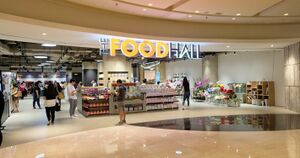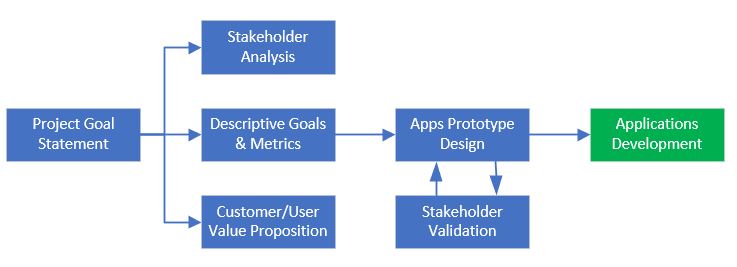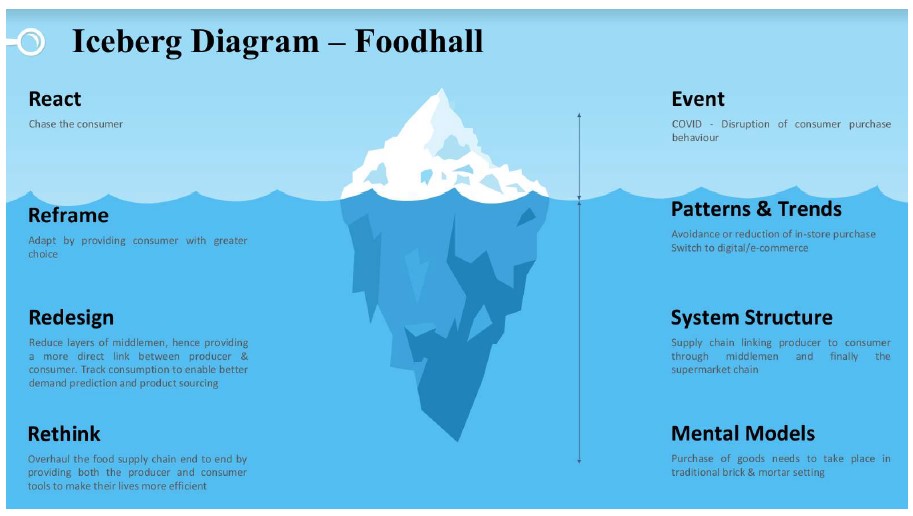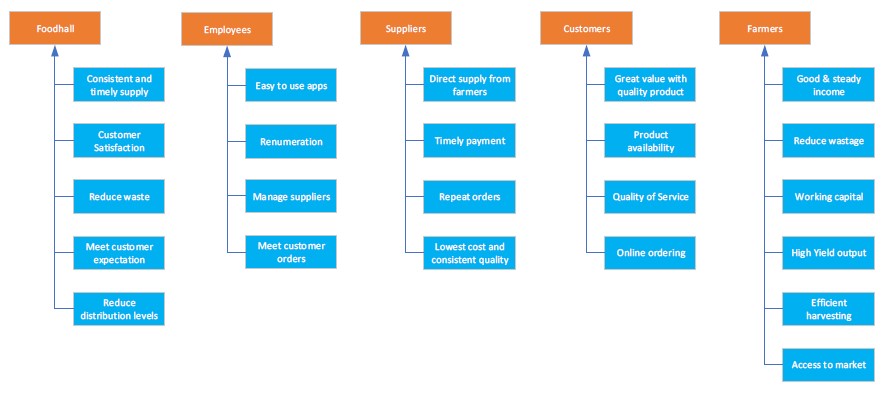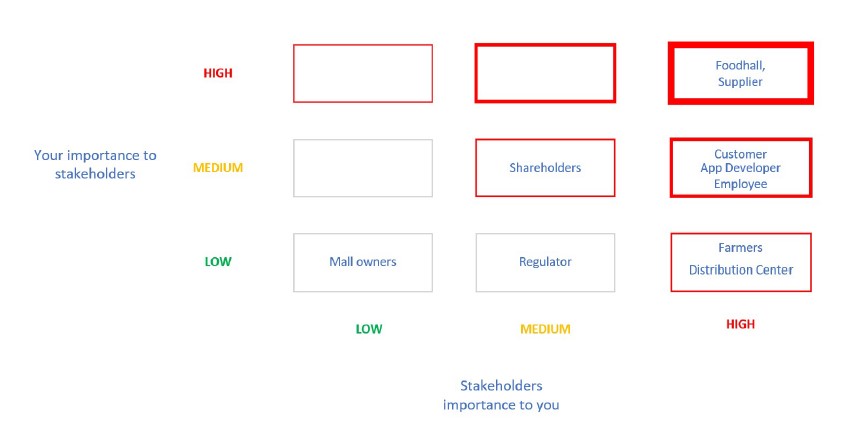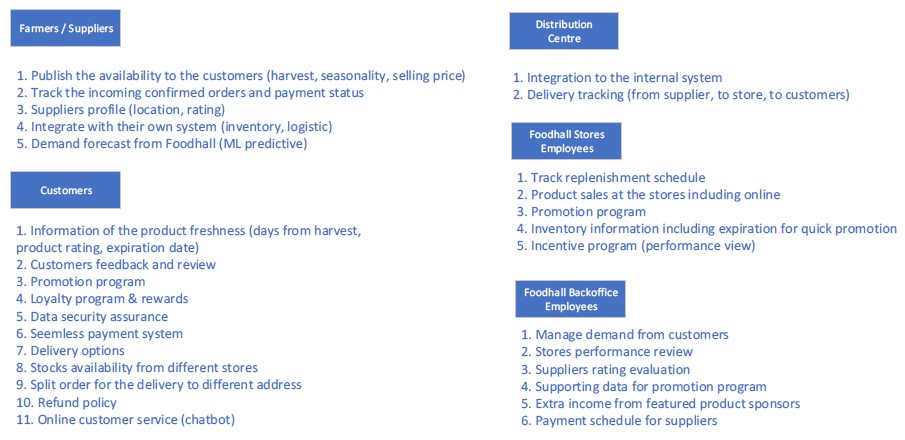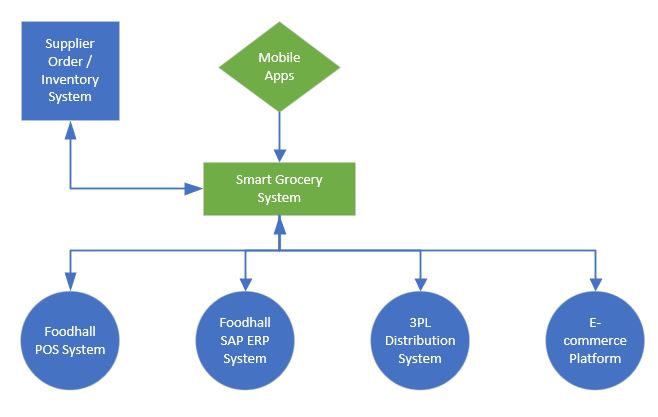Difference between revisions of "HDX Team 3 - Smart Grocery"
imported>Sharnyo |
imported>Baliforester |
||
| (106 intermediate revisions by 2 users not shown) | |||
| Line 1: | Line 1: | ||
=Background= | =Project Background= | ||
[[File:Foodhall dept store.jpg|thumb]] | [[File:Foodhall dept store.jpg|thumb]] | ||
The Foodhall is one of PT Mitra Adiperkasa Tbk business segments. The business is grocery retail with two types of premium supermarket concepts: The Foodhall, a large format supermarket and Daily Foodhall, a smaller format supermarket located mostly in residential areas. Our project team has been tasked to examine Foodhall’s current retail strategy and propose viable solutions for The Foodhall. | The Foodhall is one of PT. Mitra Adiperkasa Tbk business segments. The business is grocery retail with two types of premium supermarket concepts: The Foodhall, a large format supermarket and Daily Foodhall, a smaller format supermarket located mostly in residential areas. Our project team has been tasked to examine Foodhall’s current retail strategy and propose viable solutions for The Foodhall. | ||
The COVID-19 pandemic has posed numerous challenges to businesses especially those that are operating as brick and mortar stores. It is just one of the factors listed by our stakeholders as motivation for a rethink on retail strategy. Another consideration is how Foodhall can structure an end to end solution for its supply chain that would reduce wastage, reduce middlemen, and enhance the experience for its suppliers and consumers by offering fresh foods at the best possible price and quality. | The COVID-19 pandemic has posed numerous challenges to businesses especially those that are operating as brick and mortar stores. It is just one of the factors listed by our stakeholders as motivation for a rethink on retail strategy. Another consideration is how Foodhall can structure an end to end solution for its supply chain that would reduce wastage, reduce middlemen, and enhance the experience for its suppliers and consumers by offering fresh foods at the best possible price and quality. | ||
The team got down to our challenge by first looking at the system, namely the supply chain. We used the iceberg model to identify patterns and trends as well as the mental models, we also looked at our system problem statement to define our why of the challenge as well as the what and how. We came up with the stakeholders most relevant to the challenge at hand and their importance relative to Foodhall. Descriptive goals were then drawn up and metrics for measurement to keep us aligned to success led to the next steps which was to develop an app that would track purchase and supply data and democratise this across the entire supply chain to achieve better provision of fresh foods to the end user and reduce waste. These various steps are highlighted in the next sections. | The team got down to our challenge by first looking at the system, namely the supply chain. We used the iceberg model to identify patterns and trends as well as the mental models, we also looked at our system problem statement to define our why of the challenge as well as the what and how. We came up with the stakeholders most relevant to the challenge at hand and their importance relative to Foodhall. Descriptive goals were then drawn up and metrics for measurement to keep us aligned to success led to the next steps which was to develop an app that would track purchase and supply data and democratise this across the entire supply chain to achieve better provision of fresh foods to the end user and reduce waste. These various steps are highlighted in the next sections. | ||
{{:Smart Grocery}} | |||
=Team Members= | =Team Members= | ||
[[File:HDX members.jpg]] | [[File:HDX members.jpg]] | ||
= | = Project Milestones = | ||
[[File:Project milestones - small.jpg]] | |||
=Iceberg Model (Systems View)= | |||
The figure 1 below shows our iceberg model for our complex system from a consumer standpoint. From the business standpoint, after speaking with our stakeholder Foodhall, we understand that there is sometimes a separation in ordering patterns at the store level as opposed to head office as well as a reliance on manual modes or ordering. Hence, it would be of value to create a unified end to end solution that would be able to handle both store level and head office level ordering and supply management. In our redesign, some stakeholders such as the middlemen suppliers might be displaced especially if they cannot consistently deliver value to the produce supply chain, or integrate into the idea of information exchange and systems integration but that this exercise is worth the effort as it would bring in more predictable outcomes such as a more responsive supply chain. | |||
To | == Figure 1 : Iceberg Diagram== | ||
[[File:Iceberg model.jpg]] | |||
=Goal Statement= | |||
Our team examined the goal of the challenge and how to deliver value to the project that is representative of real success. The ‘To, By and Using’ goal statement we established is: | |||
* '''To : Reduce wastage of perishable produce, get low price for customer while improving farmers’ welfare. Reduce wastage of perishable produce, get low price for customer while improving farmers’ welfare''' | |||
* '''By : Shortening the produce supply chain through predictive orders''' | |||
* '''Using : An on-demand digital ordering system''' | |||
=Stakeholders Analysis= | |||
For an end to end solution, we identified at least 10 stakeholders. These stakeholders are relevant to the Foodhall challenge now and into the future. Figure 2 illustrates these stakeholders and their respective needs. | |||
==Figure 2 : Stakeholders Analysis== | |||
[[File:Stakeholders analysis 1.jpg]] | |||
[[File:Stakeholders analysis 2.jpg]] | |||
The stakeholders can be further defined as those who might be directly involved in the supply chain, for instance, the Farmers, Suppliers, the Distribution Centre, Foodhall itself as challenge project owner as well as those who are potentially indirectly connected such as the App Developer, Regulator, Shareholders and Mall Owners and finally both directly and indirectly, namely the Employees of Foodhall since they might be based in back office (head office) and have functions of pushing down supplies to the various store locations or front end staff who might need to make or receive stock replenishments. | |||
=Stakeholders Descriptive Goals and Metrics= | |||
We identified 14 goals for the project. 7 of these were initially deemed critical to the challenge project. This is illustrated by Figure 3. The goals in Figure 3 are not listed in sequential order. However after speaking with the stakeholder Foodhall, we now understand that a separate system is already in the works for a consumer app. | |||
This led the team to reexamine our ‘why’ of the project. We scaled down the scope of the project to only focus on the supply side. Hence the team worked on the descriptive goals that are essential to delivering an optimized supply chain that would allow for data flows between the farmers, suppliers, distribution center and Foodhall. With an increased information exchange and demand aggregation, more visibility is afforded through the entire system structure providing assurances to the farmers and suppliers as well as to Foodhall and helps to reduce wastage by only catering for demand generated by the end customer. In this way, our project is quite literally Happy Digital X as we are addressing the financial well being of the farmers and suppliers through a more predictable order which should make them happier in the longer term whilst tying up the ecosystem through a digital solution. | |||
In our revision, goals 3, 7, 8, 1 and 2 are critical in ensuring an efficient end to end supply chain. | |||
==Figure 3 : Descriptive Goals== | |||
[[File:Descriptive goals.jpg]] | |||
=Pairwise Interactions= | |||
From these ten stakeholders, we did a pairwise interaction based on a 3 by 3 grid. Figure 4 illustrates this. | |||
==Figure 4 : 3x3 matrix== | |||
[[File:Pairwise interaction.jpg]] | |||
The Foodhall and Suppliers are of highest importance to the project. Foodhall, for obvious reasons since they hold the consumption data, trends and patterns as well as the business requirements. The supplier because they are a cog in the system where they hold valuable intermediary data and represent the bridge between the farmers and the distribution centre. Of medium importance is the customer as they represent the demand side and help the project generate revenue from their orders. The app developers are of similar importance as they will be integrating all of the business requirements into an enterprise solution (SAAS) that would handle orders and order tracking for stakeholders such as the Foodhall, farmer, supplier, distribution centre. Finally employees came in at medium, as their buy-in and familiarity with any eventual system is critical for the success of implementation. | |||
=Value Propositions= | |||
Our team defined the value that a responsive supply chain would bring to our most important stakeholders. For farmers and suppliers, it would mean an opportunity to share harvest details and produce availability to Foodhall. An integrated system would also give visibility to the farmers and suppliers on incoming orders and payments to increase trust in the system. | |||
Figure 5 maps the value proposition or benefits to each of the five stakeholders. However, as mentioned earlier, Foodhall is developing a separate consumer app, so our challenge project will focus on the four stakeholders groups: farmers & suppliers, distribution center and Foodhall. | |||
==Figure 5: Benefits of an end-to-end digital supply chain system== | |||
[[File:Value propositions.jpg]] | |||
=Logical Framework= | |||
[[File:Logframe - small.jpg]] | |||
=Systems Integration= | |||
[[File:System interface.jpg]] | |||
=Application Mockup= | |||
The team prepared mockups for various use case scenarios. These include the app interface/wireframe for farmers and suppliers, distribution centre as well as Foodhall Stores and Foodhall Head Office. We further refined this mockup after having a session on 4 August with our Foodhall stakeholder. Through this session, we received valuable feedback on which aspects were important that the app could add value to the end users or facilitate decisions on product requisition. For instance, at the farmer, supplier interface, service level would be important to have. Service level is defined as the ability of the farmer/supplier to fulfil orders quantity. Our stakeholder also shared with us an example of how fruit quality is usually described or quantified: BRIX (sweetness level) and acidity (flavour). | |||
In addition, data such as size of fruit could be added to allow the end user to indicate the distinctiveness of their produce. At the store level, the interface can be further simplified. This means taking away information such as harvest information. The comments we received was that the value of our system does indeed enhance the transparency or visibility of the supply chain. The interface was also viewed as intuitive so the appraisal was that the adoption rate would be high. | |||
Another useful feedback is that with the machine learning function and better analytics, a sweet spot to push higher sales and less wastage is the ideal situation for Foodhall. The other aspect of the system is also knowledge management as data is built. | |||
The overview mockup apps can be seen here: https://www.canva.com/design/DAElt3Ex3MQ/ibkxqywzzmESd5aVs3jznA/view?utm_campaign=design | |||
=Technical Documentation= | |||
The technical documentation is attached in the following link: | |||
[[Media:FoodHallApp Technical Documentation.pdf]] | |||
=Conclusion and Acknowledgements= | |||
Every business strives for better performance. This better performance can be viewed in comparison to existing competitors and overall process improvements to their state of operations. Improvements usually come when businesses utilise systems thinking and take a hard look at their systems. They should facilitate innovation at some acceptable level of risk. Most contemporary firms are also expected by their consumers to credibly wear green credentials. | |||
For The Foodhall, less wastage and increased sales is the route that can satisfy these aspirations; better business performance through optimised orders, and green credentials through waste reduction. Our team worked closely with The Foodhall stakeholders to identify a solution that uses technology to connect the various ‘agents’, or elements in the produce chain system of The Foodhall. In the process, the connected system (order and tracking app) brings the additional value of assurance. When farmers and suppliers are assured of orders and payment through visibility on the orders segment of the app, the trust between the start of the produce chain and The Foodhall is increased. The gap we have addressed is the need for consolidation on a common platform. This is our Happy Digital X solution and service. Through the app, information sharing and analysis is encouraged, facilitated, and beneficial. When ordering behaviours and patterns become more of a science, we can ultimately achieve efficiency and accuracy of orders so that at point of sales, the right amount of product push enables better revenue, and also less waste as the orders are predicted, or predicated from past demands. Of course, we understand that beyond our proposal and mock up of the app, The Foodhall will still have to take further steps to carry forward development. | |||
Our team would like to acknowledge Mr. Kiat Boon, Head of Fresh, The Foodhall, who kindly contributed his time to review our solution, and offer his suggestions for improvement. We also like to thank our course lecturers and plenary speakers for contributing greatly to our learning. We would also like to acknowledge the other teams who generously shared their presentations and learning insights, as well as learning journey. Finally thanks to our team mates who spent many hours discussing and developing our challenge project solution. | |||
=References= | |||
To gain a better sensing of the project and being continuous learners, several sources of information proved useful to our team. These articles allowed us to gain insights into the best practises of supply chain management, in particular to the farming and grocery business | |||
The | *'''The food chain: Japanese agriculture - from farm to supermarket''' ([https://hackerfarm.jp/2019/04/the-food-chain-japanese-agriculture-from-farm-to-supermarket/ https://hackerfarm.jp/2019/04/the-food-chain-japanese-agriculture-from-farm-to-supermarket/ ]) | ||
*'''Winning the Food Fight: Best Practices for Managing Grocery Retail Supply Chains''' ([https://www.relexsolutions.com/resources/managing-grocery-retail-supply-chains/ https://www.relexsolutions.com/resources/managing-grocery-retail-supply-chains/]) | |||
*'''The secret to smarter fresh-food replenishment? Machine learning''' (https://www.mckinsey.com/industries/retail/our-insights/the-secret-to-smarter-fresh-food-replenishment-machine-learning?cid=eml-web) | |||
*'''3 Steps to a Digital Supply Chain''' (https://www.gartner.com/smarterwithgartner/3-steps-to-a-digital-supply-chain/) | |||
Latest revision as of 11:40, 28 August 2021
Project Background
The Foodhall is one of PT. Mitra Adiperkasa Tbk business segments. The business is grocery retail with two types of premium supermarket concepts: The Foodhall, a large format supermarket and Daily Foodhall, a smaller format supermarket located mostly in residential areas. Our project team has been tasked to examine Foodhall’s current retail strategy and propose viable solutions for The Foodhall.
The COVID-19 pandemic has posed numerous challenges to businesses especially those that are operating as brick and mortar stores. It is just one of the factors listed by our stakeholders as motivation for a rethink on retail strategy. Another consideration is how Foodhall can structure an end to end solution for its supply chain that would reduce wastage, reduce middlemen, and enhance the experience for its suppliers and consumers by offering fresh foods at the best possible price and quality.
The team got down to our challenge by first looking at the system, namely the supply chain. We used the iceberg model to identify patterns and trends as well as the mental models, we also looked at our system problem statement to define our why of the challenge as well as the what and how. We came up with the stakeholders most relevant to the challenge at hand and their importance relative to Foodhall. Descriptive goals were then drawn up and metrics for measurement to keep us aligned to success led to the next steps which was to develop an app that would track purchase and supply data and democratise this across the entire supply chain to achieve better provision of fresh foods to the end user and reduce waste. These various steps are highlighted in the next sections.
| Logic Frame | ||||||||||||||||
|---|---|---|---|---|---|---|---|---|---|---|---|---|---|---|---|---|
| Problem Statement: | ||||||||||||||||
| The COVID-19 pandemic has posed numerous challenges to businesses especially those that are operating as brick and mortar stores.
Our project team has been tasked to examine Foodhall’s current retail strategy and propose viable solutions for The Foodhall.
| ||||||||||||||||
| GOAL: | ||||||||||||||||
| Reduce wastage of perishable produce, get low prices for customer while improving farmers’ welfare.
| ||||||||||||||||
|
|
| ||||||||||||||
Team Members
Project Milestones
Iceberg Model (Systems View)
The figure 1 below shows our iceberg model for our complex system from a consumer standpoint. From the business standpoint, after speaking with our stakeholder Foodhall, we understand that there is sometimes a separation in ordering patterns at the store level as opposed to head office as well as a reliance on manual modes or ordering. Hence, it would be of value to create a unified end to end solution that would be able to handle both store level and head office level ordering and supply management. In our redesign, some stakeholders such as the middlemen suppliers might be displaced especially if they cannot consistently deliver value to the produce supply chain, or integrate into the idea of information exchange and systems integration but that this exercise is worth the effort as it would bring in more predictable outcomes such as a more responsive supply chain.
Figure 1 : Iceberg Diagram
Goal Statement
Our team examined the goal of the challenge and how to deliver value to the project that is representative of real success. The ‘To, By and Using’ goal statement we established is:
- To : Reduce wastage of perishable produce, get low price for customer while improving farmers’ welfare. Reduce wastage of perishable produce, get low price for customer while improving farmers’ welfare
- By : Shortening the produce supply chain through predictive orders
- Using : An on-demand digital ordering system
Stakeholders Analysis
For an end to end solution, we identified at least 10 stakeholders. These stakeholders are relevant to the Foodhall challenge now and into the future. Figure 2 illustrates these stakeholders and their respective needs.
Figure 2 : Stakeholders Analysis
The stakeholders can be further defined as those who might be directly involved in the supply chain, for instance, the Farmers, Suppliers, the Distribution Centre, Foodhall itself as challenge project owner as well as those who are potentially indirectly connected such as the App Developer, Regulator, Shareholders and Mall Owners and finally both directly and indirectly, namely the Employees of Foodhall since they might be based in back office (head office) and have functions of pushing down supplies to the various store locations or front end staff who might need to make or receive stock replenishments.
Stakeholders Descriptive Goals and Metrics
We identified 14 goals for the project. 7 of these were initially deemed critical to the challenge project. This is illustrated by Figure 3. The goals in Figure 3 are not listed in sequential order. However after speaking with the stakeholder Foodhall, we now understand that a separate system is already in the works for a consumer app.
This led the team to reexamine our ‘why’ of the project. We scaled down the scope of the project to only focus on the supply side. Hence the team worked on the descriptive goals that are essential to delivering an optimized supply chain that would allow for data flows between the farmers, suppliers, distribution center and Foodhall. With an increased information exchange and demand aggregation, more visibility is afforded through the entire system structure providing assurances to the farmers and suppliers as well as to Foodhall and helps to reduce wastage by only catering for demand generated by the end customer. In this way, our project is quite literally Happy Digital X as we are addressing the financial well being of the farmers and suppliers through a more predictable order which should make them happier in the longer term whilst tying up the ecosystem through a digital solution.
In our revision, goals 3, 7, 8, 1 and 2 are critical in ensuring an efficient end to end supply chain.
Figure 3 : Descriptive Goals
Pairwise Interactions
From these ten stakeholders, we did a pairwise interaction based on a 3 by 3 grid. Figure 4 illustrates this.
Figure 4 : 3x3 matrix
The Foodhall and Suppliers are of highest importance to the project. Foodhall, for obvious reasons since they hold the consumption data, trends and patterns as well as the business requirements. The supplier because they are a cog in the system where they hold valuable intermediary data and represent the bridge between the farmers and the distribution centre. Of medium importance is the customer as they represent the demand side and help the project generate revenue from their orders. The app developers are of similar importance as they will be integrating all of the business requirements into an enterprise solution (SAAS) that would handle orders and order tracking for stakeholders such as the Foodhall, farmer, supplier, distribution centre. Finally employees came in at medium, as their buy-in and familiarity with any eventual system is critical for the success of implementation.
Value Propositions
Our team defined the value that a responsive supply chain would bring to our most important stakeholders. For farmers and suppliers, it would mean an opportunity to share harvest details and produce availability to Foodhall. An integrated system would also give visibility to the farmers and suppliers on incoming orders and payments to increase trust in the system.
Figure 5 maps the value proposition or benefits to each of the five stakeholders. However, as mentioned earlier, Foodhall is developing a separate consumer app, so our challenge project will focus on the four stakeholders groups: farmers & suppliers, distribution center and Foodhall.
Figure 5: Benefits of an end-to-end digital supply chain system
Logical Framework
Systems Integration
Application Mockup
The team prepared mockups for various use case scenarios. These include the app interface/wireframe for farmers and suppliers, distribution centre as well as Foodhall Stores and Foodhall Head Office. We further refined this mockup after having a session on 4 August with our Foodhall stakeholder. Through this session, we received valuable feedback on which aspects were important that the app could add value to the end users or facilitate decisions on product requisition. For instance, at the farmer, supplier interface, service level would be important to have. Service level is defined as the ability of the farmer/supplier to fulfil orders quantity. Our stakeholder also shared with us an example of how fruit quality is usually described or quantified: BRIX (sweetness level) and acidity (flavour).
In addition, data such as size of fruit could be added to allow the end user to indicate the distinctiveness of their produce. At the store level, the interface can be further simplified. This means taking away information such as harvest information. The comments we received was that the value of our system does indeed enhance the transparency or visibility of the supply chain. The interface was also viewed as intuitive so the appraisal was that the adoption rate would be high.
Another useful feedback is that with the machine learning function and better analytics, a sweet spot to push higher sales and less wastage is the ideal situation for Foodhall. The other aspect of the system is also knowledge management as data is built.
The overview mockup apps can be seen here: https://www.canva.com/design/DAElt3Ex3MQ/ibkxqywzzmESd5aVs3jznA/view?utm_campaign=design
Technical Documentation
The technical documentation is attached in the following link: Media:FoodHallApp Technical Documentation.pdf
Conclusion and Acknowledgements
Every business strives for better performance. This better performance can be viewed in comparison to existing competitors and overall process improvements to their state of operations. Improvements usually come when businesses utilise systems thinking and take a hard look at their systems. They should facilitate innovation at some acceptable level of risk. Most contemporary firms are also expected by their consumers to credibly wear green credentials.
For The Foodhall, less wastage and increased sales is the route that can satisfy these aspirations; better business performance through optimised orders, and green credentials through waste reduction. Our team worked closely with The Foodhall stakeholders to identify a solution that uses technology to connect the various ‘agents’, or elements in the produce chain system of The Foodhall. In the process, the connected system (order and tracking app) brings the additional value of assurance. When farmers and suppliers are assured of orders and payment through visibility on the orders segment of the app, the trust between the start of the produce chain and The Foodhall is increased. The gap we have addressed is the need for consolidation on a common platform. This is our Happy Digital X solution and service. Through the app, information sharing and analysis is encouraged, facilitated, and beneficial. When ordering behaviours and patterns become more of a science, we can ultimately achieve efficiency and accuracy of orders so that at point of sales, the right amount of product push enables better revenue, and also less waste as the orders are predicted, or predicated from past demands. Of course, we understand that beyond our proposal and mock up of the app, The Foodhall will still have to take further steps to carry forward development.
Our team would like to acknowledge Mr. Kiat Boon, Head of Fresh, The Foodhall, who kindly contributed his time to review our solution, and offer his suggestions for improvement. We also like to thank our course lecturers and plenary speakers for contributing greatly to our learning. We would also like to acknowledge the other teams who generously shared their presentations and learning insights, as well as learning journey. Finally thanks to our team mates who spent many hours discussing and developing our challenge project solution.
References
To gain a better sensing of the project and being continuous learners, several sources of information proved useful to our team. These articles allowed us to gain insights into the best practises of supply chain management, in particular to the farming and grocery business
- The food chain: Japanese agriculture - from farm to supermarket (https://hackerfarm.jp/2019/04/the-food-chain-japanese-agriculture-from-farm-to-supermarket/ )
- Winning the Food Fight: Best Practices for Managing Grocery Retail Supply Chains (https://www.relexsolutions.com/resources/managing-grocery-retail-supply-chains/)
- The secret to smarter fresh-food replenishment? Machine learning (https://www.mckinsey.com/industries/retail/our-insights/the-secret-to-smarter-fresh-food-replenishment-machine-learning?cid=eml-web)
- 3 Steps to a Digital Supply Chain (https://www.gartner.com/smarterwithgartner/3-steps-to-a-digital-supply-chain/)
